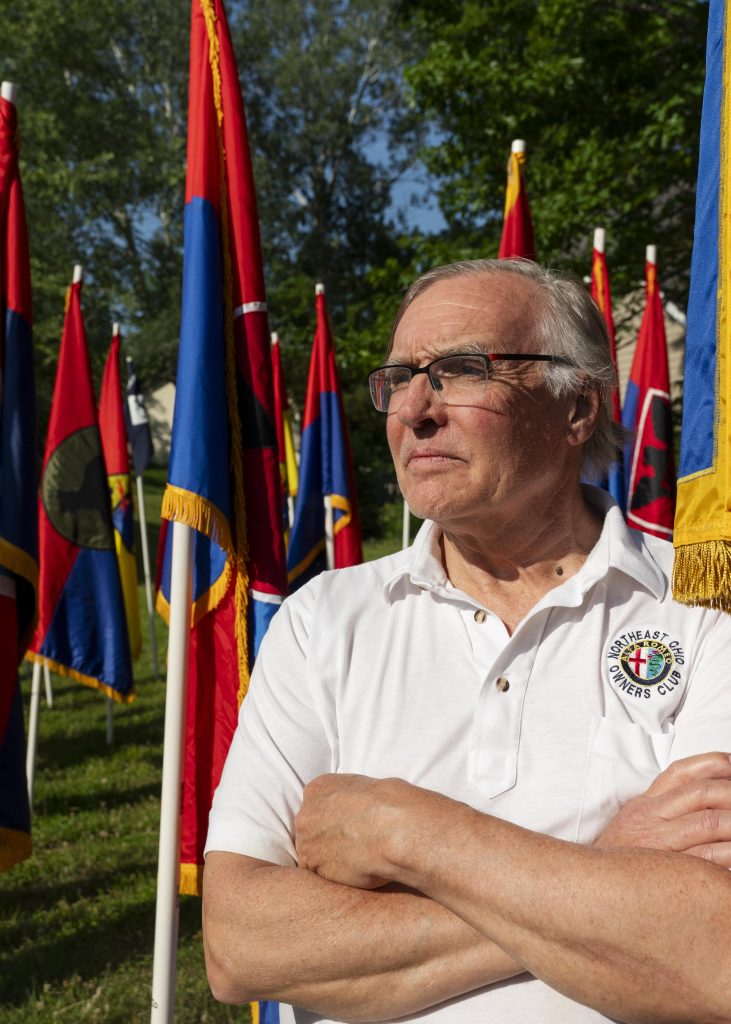Photos by L.G. Patterson

Although he is a walking encyclopedia of knowledge about military flags and battles, it is what the flags mean to him — the lost lives of those who fought beneath them — that inspires him. Before signing his name at the bottom of any emails, he precedes it with the words, “We w ill remember them.”
More than just remembering them, Meyer has found a way to honor their sacrifice. He has meticulously researched the flags of hundreds of military brigades, divisions and even war ships that have been sunk. He learns their insignia, their colors, the images that adorn them. Then, he pays a company that employs disabled veterans to make copies of the flags.
Because of military law and policy, each flag must contain at least one “fatal flaw,” an intentional deviation from the original that marks it as an inexact copy. One hundred and forty-seven different flags are stored in his garage. Others fly over Flanders Fields in Belgium and France, and over many American World War I cemeteries in Europe. Closer to home, they have been flown at the National World War I Museum and Memorial in Kansas City, where Meyer volunteers. A few years ago, Gov. Mike Parson asked Meyer to hoist his flags on the state Capitol grounds for Memorial Day. And Meyer’s flags are occasionally flown in parades and displayed graveside at funeral services of veterans he attends.
Whenever a veteran or official calls him requesting a flag of their division to use in a parade, Meyer orders one to be created and donates it. “The agreement I have with veterans is ‘I’ll have the flag made; you march it; I cover the cost,’” Meyer says. When asked why he does this, he answers quietly, “If I don’t do this, no one else will.”
Meyer is not a gung-ho military man, glorifying war and weaponry. In fact, as a young man, he was arrested for protesting the Vietnam War. Although he prefers to receive neither attention nor praise for his generosity and his fervent belief in the importance of honoring the military’s dead, he carries in his back pocket a challenge medallion given to him by Gen. Mark Milley, chairman of the Joint Chiefs of Staff. Challenge coins are presented to recognize achievement of excellence in activities that support the armed forces. Gen. Milley handed the medallion to Meyer on Nov. 11, 2018, in Suresnes, France, at the World War I Centenary, a project that included Meyer’s flags and which he had helped facilitate.
Meyer wasn’t always committed to displaying and distributing military flags. Before retiring in 2012, he taught business management as a professor at the University of Akron. In 2007, he traveled to Tilburg University in the Netherlands to present a paper at a conference. While in Europe, he made arrangements to walk in the Poppy Parade in Ypres. “I had no idea what I was getting myself into,” he says.
This solemn parade starts at St. George Memorial Church and ends at the Menin Gate, which commemorates the more than 54,000 British and Commonwealth soldiers missing in the battlefield area of the Ypres Salient in Belgium. Later, he visited cemeteries and walked on battlefields — places that once were the sites of almost unimaginable carnage that had become peaceful countryside.
He was amazed at how few Americans had visited these famous cemeteries. Something about the place, the people he met and the feelings it stirred in him, convinced him that he should take it upon himself to do something so that the dead should not be forgotten. Meyer considers the experience a religious revelation that changed the focus of his life.
In addition to his flag collection and distribution, Meyer has his own version of “Honor Flights” to remind veterans that their service to the country was not taken for granted. Instead of flying veterans to Washington, D.C., he has made videos of various battle sites and shared them with veterans who fought on them.
His commitment to honor the dead led him to a multi-year crusade through a tangle of bureaucratic hierarchies that resulted in the construction of modern bathroom facilities at Flanders Fields. This may sound like a humble accomplishment, but it was a major effort and has made it easier for more people to visit the memorial.
Since 2012, Meyer has been accompanied on some of his trips by his wife, Ann, a retired special education teacher. “I have an agreement with Ann,” he says. “We can do war stuff for a couple days, then we have to do something lighter, like visit Vienna or Paris.”
Ann isn’t as engrossed in military history as her husband, “but I’m there for support,” she says. “I enjoy seeing the cemeteries and the peaceful chapels.”
The couple both look forward to their next trip to Europe — Ann, for enjoying the cultures of various countries, the museums and the people; David, for a chance to delve into history and rescue from it the memory of those whose lives were cut short or drastically changed by war.


